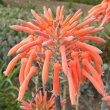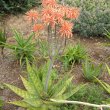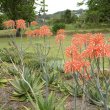Aloe maculata - previously Aloe sapinaria
| Botanical Name | Aloe maculata - previously Aloe sapinaria |
|||||||||||
| Family | Aloeaceae - The aloe family. |
|||||||||||
| Pronunciation | AL-oh mak-yuh-LAH-tuh |
|||||||||||
| Common Name(s) |
Afrikaans: Bontaalwyn
IsiXhosa: ingcelwane; intelezi
Sesotho: Lekhala; Lekhala La Thaba
|
|||||||||||
| Plant Group |
|
|||||||||||
| Plant Size |
|
|||||||||||
| Position |
|
|||||||||||
| General Information |
|
|||||||||||
| Specific Information | Aloe maculata is a stemless aloe, loosely classified as belonging to the group of spotted aloes. The leaves are broadly triangular, curve slightly backwards at the ends, are liberally spotted, have sharp brown teeth along the edges and are arranged in an open, flat rosette. Flowering times are very variable with various forms flowering in summer, winter or spring. This is a very pretty aloe when in flower, especially if one is not that attracted to the spiky form of most aloe flowers. I have only come across the pink form but the pictures I have seen of the yellow and orange forms certainly make it worth while to try to get hold of them.
|
|||||||||||
| Ad Break | ||||||||||||
| Flowers | ||||||||||||
| Description | a flat topped, loose cluster of lax tubular-shaped blooms on a branched stem |
|||||||||||
| Season |
|
|||||||||||
| Colour |
|
|||||||||||
| Growth Rate |
|
|||||||||||
| Plant Uses |
|
|||||||||||
| Distribution and Habitat | from the Cape Peninsula in the Western Cape to the Eastern Cape Province, the eastern Free State, through KwaZulu-Natal and Mpumalanga to Zimbabwe, in rocky outcrops, thicket vegetation and grasslands |
|||||||||||
| Planting Suggestions | Plant in well drained soil mixed with compost. Watch out for snout beetle damage: http://kumbulanursery.co.za/blog/snout-beetle-damage-done-to-aloes |
|||||||||||
| Medicinal Uses | It has been reported that sap from the leaves is used as a substitute for soap. |
|||||||||||
| Ad Break | ||||||||||||








Discuss this plant
Share knowledge, ask a question or give an experience.